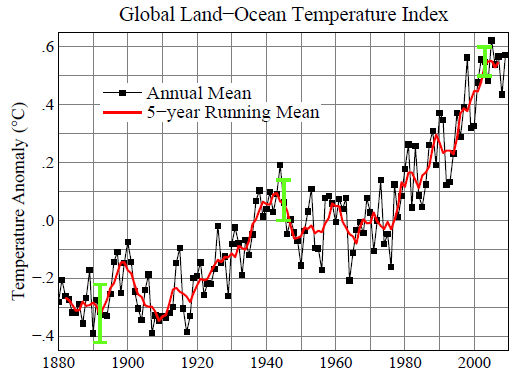Although the bulk of photovoltaic devices today are used for purely practical and economic reasons, a potential benefit of photovoltaics is that PV is one of the most environmentally benign of any electricity generating source. The environmental impact of electricity generation, particularly the greenhouse effect, adds an important reason for examining photovoltaics. A brief overview of the greenhouse effect is given below.
The Earth's temperature is a result of an equilibrium established between the incoming radiation from the sun and the energy radiated into space by the Earth. The outgoing radiation emitted by the Earth is strongly affected by the presence and composition of the Earth's atmosphere. If we had no atmosphere, as on the moon, the average temperature on the Earth's surface would be about -18°C. However, a natural background level of 270 ppm carbon dioxide (CO2) in the atmosphere absorbs outgoing radiation, thereby keeping this energy in the atmosphere and warming the Earth. The atmosphere causes the Earth's temperature to be about 15°C on average, 33°C above the moon's. Carbon dioxide absorbs strongly in the 13-19 µm wavelength band and water vapour, another atmospheric gas, absorbs strongly in the 4-7 µm wavelength band. Most outgoing radiation (70%) escapes in the "window" between 7-13 µm.
Human activities are increasingly releasing "anthropogenic gases" into the atmosphere, which absorb in the 7-13 µm wavelength range, particularly carbon dioxide, methane, ozone, nitrous oxides and chlorofluorocarbons (CFC's). These gases prevent the normal escape of energy and potentially will lead to an increase in terrestrial temperature. Present evidence suggests "effective" CO2 levels will double by 2030, causing global warming of 1~4°C. This would lead to changes in wind patterns and rainfall and as a result may cause the interior of continents to dry out and cause the Earth's oceans to rise. Further increases in the release of anthropogenic gases would, of course, cause more severe effects.
Correlation of the rise in atmospheric carbon dioxide concentration (blue line) with the rise in average temperature (red line)1.
The graph above only goes to the mid-90s since that was the time we started writing the PVCDROM. At the time there was considerable discussion about whether the warming was a trend or a statistical fluctuation. There was some hope that the average temperatures would go down again to the level of the statistical average. In the intervening years the temperature of the earth has continued to rise as shown in the graph below:

Average surface temperature of the earth. Temperatures are continuing their upward rise.NASA20102
Clearly, human activities have now reached a scale where they are impacting on the planet's environment and its attractiveness to humans. The side-effects could be devastating and technologies with low environmental impact and no "greenhouse gas" emissions are likely to be of increasing importance over the coming decades. Since the energy sector is the major producer of "greenhouse gases" via the combustion of fossil fuels, technologies such as photovoltaics, which can substitute for fossil fuels, must increasingly be used 3.
- 1. , “Sun’s Role in Warming Is Discounted”, Science, vol. 268, pp. 28 - 29, 1995.
- 2. , “Global temperature change”, Proceedings of the National Academy of Sciences, vol. 103, pp. 14288 - 14293, 2006.
- 3. , The Role of Photovoltaics in Reducing Greenhouse Gas Emissions. Canberra: Australian Government Publishing Service, 1991.
- Log in or register to post comments
- 3 comment(s)
 Español
Español 한국어
한국어 Русский
Русский 简体中文
简体中文 Bahasa Indonesia
Bahasa Indonesia
